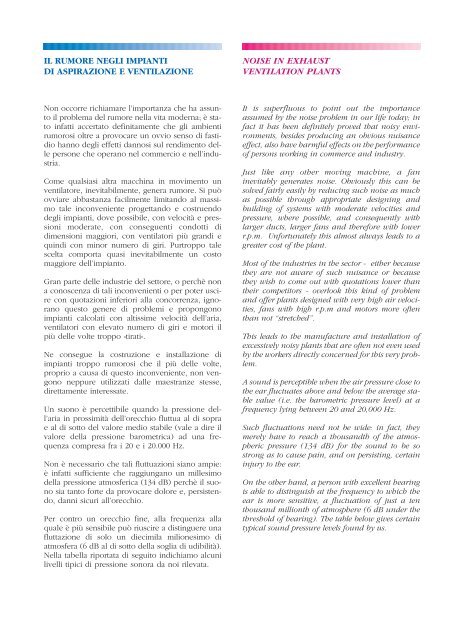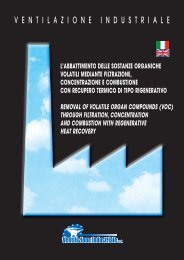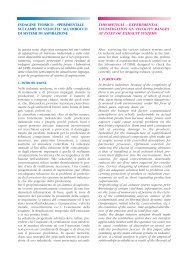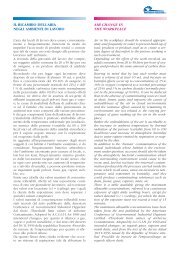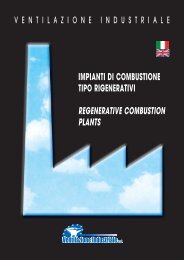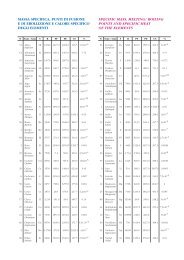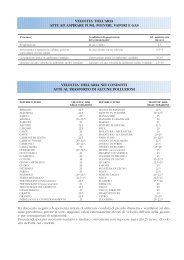IL RUMORE NEGLI IMPIANTI DI ASPIRAZIONE E VENTILAZIONE ...
IL RUMORE NEGLI IMPIANTI DI ASPIRAZIONE E VENTILAZIONE ...
IL RUMORE NEGLI IMPIANTI DI ASPIRAZIONE E VENTILAZIONE ...
You also want an ePaper? Increase the reach of your titles
YUMPU automatically turns print PDFs into web optimized ePapers that Google loves.
<strong>IL</strong> <strong>RUMORE</strong> <strong>NEGLI</strong> <strong>IMPIANTI</strong><br />
<strong>DI</strong> <strong>ASPIRAZIONE</strong> E VENT<strong>IL</strong>AZIONE<br />
NOISE IN EXHAUST<br />
VENT<strong>IL</strong>ATION PLANTS<br />
Non occorre richiamare l’importanza che ha assunto<br />
il problema del rumore nella vita moderna; è stato<br />
infatti accertato definitamente che gli ambienti<br />
rumorosi oltre a provocare un ovvio senso di fastidio<br />
hanno degli effetti dannosi sul rendimento delle<br />
persone che operano nel commercio e nell’industria.<br />
Come qualsiasi altra macchina in movimento un<br />
ventilatore, inevitabilmente, genera rumore. Si può<br />
ovviare abbastanza facilmente limitando al massimo<br />
tale inconveniente progettando e costruendo<br />
degli impianti, dove possibile, con velocità e pressioni<br />
moderate, con conseguenti condotti di<br />
dimensioni maggiori, con ventilatori più grandi e<br />
quindi con minor numero di giri. Purtroppo tale<br />
scelta comporta quasi inevitabilmente un costo<br />
maggiore dell’impianto.<br />
Gran parte delle industrie del settore, o perchè non<br />
a conoscenza di tali inconvenienti o per poter uscire<br />
con quotazioni inferiori alla concorrenza, ignorano<br />
questo genere di problemi e propongono<br />
impianti calcolati con altissime velocità dell’aria,<br />
ventilatori con elevato numero di giri e motori il<br />
più delle volte troppo «tirati».<br />
Ne consegue la costruzione e installazione di<br />
impianti troppo rumorosi che il più delle volte,<br />
proprio a causa di questo inconveniente, non vengono<br />
neppure utilizzati dalle maestranze stesse,<br />
direttamente interessate.<br />
Un suono è percettibile quando la pressione dell’aria<br />
in prossimità dell’orecchio fluttua al di sopra<br />
e al di sotto del valore medio stabile (vale a dire il<br />
valore della pressione barometrica) ad una frequenza<br />
compresa fra i 20 e i 20.000 Hz.<br />
Non è necessario che tali fluttuazioni siano ampie:<br />
è infatti sufficiente che raggiungano un millesimo<br />
della pressione atmosferica (134 dB) perchè il suono<br />
sia tanto forte da provocare dolore e, persistendo,<br />
danni sicuri all’orecchio.<br />
Per contro un orecchio fine, alla frequenza alla<br />
quale è più sensibile può riuscire a distinguere una<br />
fluttazione di solo un diecimila milionesimo di<br />
atmosfera (6 dB al di sotto della soglia di udibilità).<br />
Nella tabella riportata di seguito indichiamo alcuni<br />
livelli tipici di pressione sonora da noi rilevata.<br />
It is superfluous to point out the importance<br />
assumed by the noise problem in our life today; in<br />
fact it has been definitely proved that noisy environments,<br />
besides producing an obvious nuisance<br />
effect, also have harmful effects on the performance<br />
of persons working in commerce and industry.<br />
Just like any other moving machine, a fan<br />
inevitably generates noise. Obviously this can be<br />
solved fairly easily by reducing such noise as much<br />
as possible through appropriate designing and<br />
building of systems with moderate velocities and<br />
pressure, where possible, and consequently with<br />
larger ducts, larger fans and therefore with lower<br />
r.p.m. Unfortunately this almost always leads to a<br />
greater cost of the plant.<br />
Most of the industries in the sector - either because<br />
they are not aware of such nuisance or because<br />
they wish to come out with quotations lower than<br />
their competitors - overlook this kind of problem<br />
and offer plants designed with very high air velocities,<br />
fans with high r.p.m and motors more often<br />
than not “stretched”.<br />
This leads to the manufacture and installation of<br />
excessively noisy plants that are often not even used<br />
by the workers directly concerned for this very problem.<br />
A sound is perceptible when the air pressure close to<br />
the ear fluctuates above and below the average stable<br />
value (i.e. the barometric pressure level) at a<br />
frequency lying between 20 and 20,000 Hz.<br />
Such fluctuations need not be wide: in fact, they<br />
merely have to reach a thousandth of the atmospheric<br />
pressure (134 dB) for the sound to be so<br />
strong as to cause pain, and on persisting, certain<br />
injury to the ear.<br />
On the other hand, a person with excellent hearing<br />
is able to distinguish at the frequency to which the<br />
ear is more sensitive, a fluctuation of just a ten<br />
thousand millionth of atmosphere (6 dB under the<br />
threshold of hearing). The table below gives certain<br />
typical sound pressure levels found by us.
dB (di pressione)<br />
0 SOGLIA <strong>DI</strong> U<strong>DI</strong>B<strong>IL</strong>ITÀ (U<strong>DI</strong>TO FINE)<br />
10 MORMORIO LEGGERO<br />
20 STORMIR <strong>DI</strong> FOGLIE<br />
35 RESIDENZA PRIVATA (NON OCCUPATA)<br />
40 BIBLIOTECA<br />
45 UFFICI PRIVATI TRANQU<strong>IL</strong>LI<br />
50 UFFICI IN GENERE<br />
60 CONVERSAZIONE<br />
70 UFFICI MECCANIZZATI<br />
80 OFFICINE <strong>DI</strong> MACCHINE UTENS<strong>IL</strong>I<br />
85 TRAM METROPOLITANA<br />
90 SALE MACCHINE<br />
95 CABINE <strong>DI</strong> P<strong>IL</strong>OTAGGIO<br />
100 MARTELLO PNEUMATICO<br />
110 OFFICINE <strong>DI</strong> COSTRUZIONE CALDARERIA<br />
120 AEREI IN DECOLLO A 30 MT.<br />
130 SOGLIA <strong>DI</strong> DOLORE<br />
dB (of pressure)<br />
0 THRESHOLD OF HEARING (EXCELLENT HEARING)<br />
10 SOFT WHISPER<br />
20 RUSTLING LEAVES<br />
35 PRIVATE RESIDENCE (NOT OCCUPIED)<br />
40 LIBRARY<br />
45 QUIET PRIVATE OFFICES<br />
50 OFFICES IN GENERAL<br />
60 CONVERSATION<br />
70 MECHANIZED OFFICES<br />
80 MACHINE TOOL WORKSHOPS<br />
85 TRAM / METRO<br />
90 ENGINE ROOMS<br />
95 P<strong>IL</strong>OTS' CABIN<br />
100 PNEUMATIC HAMMER<br />
110 BO<strong>IL</strong>ER-MAKING WORKSHOPS<br />
120 AICRAFT TAKING OFF AT 30 MT.<br />
130 THRESHOLD OF PAIN<br />
FONTI <strong>DI</strong> <strong>RUMORE</strong><br />
Il rumore prodotto da impianti di aspirazione e<br />
ventilazione può essere suddiviso in tre principali<br />
categorie:<br />
1) rumore meccanico; 2) rumore per vortici; 3)<br />
rumore di rotazione.<br />
Il rumore meccanico è prodotto dai supporti delle<br />
parti rotanti, cinghie, motori di comando, ecc.,<br />
dal tamburellare e dal battere di parti della struttura<br />
non sufficientemente rigide o non adeguatamente<br />
bloccate. La molestia provocata dal rumore meccanico<br />
può essere virtualmente eliminata ricorrendo<br />
a giunzioni ed a supporti antivibranti ed anche<br />
a pesanti blocchi di fondazione per ventilatori e<br />
motori.<br />
Il rumore per vortici costituisce di solito la maggior<br />
parte del rumore prodotto dal ventilatore,<br />
prende origine in zone di afflusso turbolento ed è<br />
perciò strettamente dipendente dalle perdite dovute<br />
alle imperfezioni aerodinamiche nella progettazione<br />
del ventilatore. E’ un rumore che si riscontra<br />
anche al passaggio dell’aria, alle griglie, nelle curve<br />
troppo strette, nelle batterie di riscaldamento ed<br />
in altre parti dell’impianto dove si verificano perdite<br />
di carico. L’intensità acustica di tale suono<br />
aumenta molto rapidamente all’aumentare della<br />
velocità dell’aria e si moltiplica da 30 a 250 volte<br />
(vale a dire aumenta di 15-24 dB) ogni volta che la<br />
velocità raddoppia.<br />
Il rumore di rotazione è un rumore che i ventilatori<br />
devono inevitabilmente produrre, causa<br />
l’azione esercitata dalla ventola sull’aria.<br />
Questo si verifica perchè le forze agenti fra la ventola<br />
e l’aria non sono distribuite uniformemente<br />
entro la carcassa, ma sono concentrate in prossimità<br />
delle singole pale, generando pressioni statiche<br />
crescenti e decrescenti, le quali, benché stabili in<br />
sé, ruotano con la ventola. Esse perciò producono<br />
in un punto stabile in prossimità della ventola l’effetto<br />
di una pressione pulsante. La caratteristica che<br />
NOISE SOURCES<br />
The noise produced by exhaust ventilation plants<br />
can be subdivided into three main categories:<br />
1) mechanical noise; 2) rumble noise; 3) noise of<br />
rotation.<br />
Mechanical noise is produced by the bearings of<br />
the rotating parts, belts, drive motors, etc., by the<br />
drumming and knocking of insufficiently rigid or<br />
insecurely fastened structure. The nuisance caused<br />
by mechanical noise can be practically eliminated<br />
by making use of vibration-damping supports and<br />
joints as well as heavy foundation blocks for fans<br />
and motors.<br />
Rumble noise making up most of the noise produced<br />
by the fan, originates in turbulent flow<br />
areas. Hence it depends strictly on the losses due to<br />
aerodynamic imperfections in the fan design. It is<br />
the noise encountered also when the air flows<br />
through grids, too sharp bends, in heating coils,<br />
and in other parts of the plant where pressure drops<br />
occur. The acoustic intensity of such sound increases<br />
very suddenly as the air velocity is increased,<br />
and it multiplied by 30 to 250 times (i.e. increase of<br />
15 to 24 dB) each time the velocity is doubled.<br />
Noise of rotation is a noise inevitably produced<br />
by the fans owing to the action exerted by the<br />
impeller on the air.<br />
This occurs because the forces acting between the<br />
fan and air are not distributed uniformly inside the<br />
housing, rather they are concentrated in the vicinity<br />
of the single blades, thus generating increasing<br />
and decreasing static pressures which, although<br />
stable in themselves, rotate with the fan. Hence they<br />
produce the effect of pulsating pressure in a stable<br />
point close to the impeller. The distinctive characteristic<br />
of the noise of rotation is that all the energy is<br />
concentrated in pure sounds. The main frequency<br />
of these pure sounds is always equal to the number<br />
of impeller blades, multiplied by the speed expressed<br />
in revs. per second; however they normally have, in
contraddistingue il rumore di rotazione è che tutta<br />
l’energia è concentrata in suoni puri. La frequenza<br />
principale di questi suoni puri è sempre uguale al<br />
numero di pale della ventola, moltiplicato per la<br />
velocità espressa in giri al secondo, ma si hanno di<br />
solito, in diverse proporzioni, altri suoni di frequenza<br />
pari a 2, 3, 4 o più volte di questa frequenza<br />
“fondamentale”. Il rumore di rotazione può<br />
aumentare notevolmente a causa di un ostacolo<br />
posto vicino alla ventola e quindi tali ostruzioni<br />
andrebbero evitate oppure, se non sono inevitabili,<br />
dovrebbero essere accordate con un buon profilo<br />
aerodinamico. Gli effetti peggiori sono dovuti a<br />
ostruzioni poste a monte di una ventola a flusso<br />
assiale, poiché la scia di aria turbolenta dietro<br />
l’ostruzione verrà colpita successivamente dalle<br />
pale della ventola; gli stessi effetti si produrranno<br />
nel caso di ostacoli situati a valle di una girante<br />
centrifuga (per esempio una serranda mal sagomata<br />
o mal piazzata) a causa di pulsazioni di pressione<br />
provocate dall’impatto con l’ostruzione, da una<br />
parte di punte successive di velocità provenienti<br />
dalle pale della girante.<br />
Tutti gli argomenti citati fino a questo punto hanno<br />
lo scopo di far comprendere come anche negli<br />
impianti di aspirazione e ventilazione sia necessario<br />
sviluppare uno studio e una progettazione<br />
attenti, accurati e diversi per ogni singolo problema<br />
e per ogni singola installazione. Purtroppo<br />
oggi, proprio da molte ditte costruttrici di impianti,<br />
queste regole vengono spesso trascurate quando<br />
addirittura non sono conosciute e ne derivano<br />
quindi dei prodotti ben poco validi tecnicamente<br />
che inducono spesso la Clientela a ritenere che tutti<br />
gli impianti di aspirazione e ventilazione possano<br />
essere facilmente costruiti da una qualsiasi officina<br />
meccanica da carpenteria.<br />
Vorremmo infine richiamare l’attenzione dei<br />
responsabili di questi impianti sull’importanza di<br />
una regolare e accurata manutenzione degli stessi,<br />
al fine di conservarne il massimo rendimento ed<br />
evitare guasti e fermi che si ripercuoterebbero<br />
anche sulla produzione.<br />
CORRISPONDENZA TRA LIVELLO <strong>DI</strong> PRESSIO-<br />
NE E LIVELLO <strong>DI</strong> POTENZA ACUSTICA<br />
Abbiamo visto che il costruttore può garantire solo<br />
i valori di potenza acustica e non quelli di pressione<br />
che per altro determinano la sensazione di<br />
rumore. Fra potenza e pressione esistono rapporti<br />
che sono legati all’ambiente e alla distanza. In un<br />
ambiente chiuso la relazione tra potenza e pressione<br />
acustica è la seguente:<br />
Q 4<br />
La = Lp - 10 log (––––––– + ––––)<br />
4π d 2 R<br />
different proportions, other sounds of frequency<br />
equal to 2, 3, 4 or more times this “fundamental”<br />
frequency. The noise of rotation may increase considerably<br />
because of an obstacle placed close to the<br />
fan. Therefore such obstructions could be avoided<br />
or else, if they are not inevitable, they could be<br />
tuned with a good aerodynamic profile. The worst<br />
effects are due to obstructions placed upstream of a<br />
propeller fan because the trail of turbulent air<br />
behind the obstruction would then be hit by the<br />
impeller blades; the same effects would be produced<br />
also in the case of obstacles located downstream of<br />
a centrifugal fan (e.g. a poorly positioned or poorly<br />
shaped damper) owing to pressure pulsations<br />
caused by the impact with the obstruction by another<br />
part of the subsequent peak speed velocity peaks<br />
coming from the impeller blades.<br />
All the arguments mentioned up till now in order to<br />
understand how it is necessary, as also in exhaust<br />
ventilation plants, to carry out a careful study and<br />
design which is precise and different for each single<br />
problem and for each single installation.<br />
Unfortunately many plant engineering companies<br />
are often the very ones to ignore these rules, or they<br />
may even not to be acquainted with them. As a<br />
result, technically invalid products appears, often<br />
causing customer to think that all exhaust ventilation<br />
plants can easily be built by just any fabricated<br />
metal workshop.<br />
Finally we wish to draw the attention of those in<br />
charge of such plants concerning the importance of<br />
periodic and accurate plant maintenance in order<br />
to ensure maximum efficiency as well as to avoid<br />
failures and shut-downs which would also have<br />
negative effect on production.<br />
CORRESPONDENCE BETWEEN PRESSURE<br />
LEVEL AND SOUND POWER LEVEL<br />
We have already seen that the manufacturer can<br />
only guarantee sound power levels and not pressure<br />
levels which determine the sensation of noise.<br />
There are ratios between sound power and pressure,<br />
depending on the environment and distance.<br />
In a closed environment, the relationship between<br />
sound pressure and power is as follows:<br />
Q 4<br />
La = Lp - 10 log (––––––– + ––––)<br />
4π d 2 R
dove: Q = fattore di direzionalità<br />
d = distanza in metri<br />
S 1<br />
R costante ambientale = –––––<br />
1 –<br />
1S1+2S2+…+3S3<br />
coeff. di assorb. medio ponderato= ––––––––––––<br />
S1+S2+…+S3<br />
S = superficie totale in m 2<br />
1…3 = coeff. di assorb. relativi alle superf.<br />
componenti il locale S1 … S3<br />
All’aperto la relazione tra potenza La e pressione<br />
Lp è la seguente:<br />
La = Lp + 10 log 4πd 2 /Q<br />
dove: d = distanza in metri<br />
Q = fattore di direzionalità<br />
Le situazioni pratiche acusticamente definite che si<br />
verificano all’aperto sono tre:<br />
Q = 2 pavimento senza ostacoli circostanti<br />
Q = 4 pavimento con una parete verticale vicina<br />
alla sorgente di rumore<br />
Q = 8 pavimento con due pareti vicine alla sorgente<br />
di rumore (angolo).<br />
where: Q = directionality factor<br />
d = distance in metres<br />
S 1<br />
R environmental constant = –––––<br />
1 –<br />
1S1+2S2+…+3S3<br />
coeff. of mean weighted absorp.= ––––––––––––<br />
S1+S2+…+S3<br />
S = total surface in m 2<br />
1... 3 = coeff. of absorp. regarding surface<br />
comprising the room S1 … S3<br />
In the open, relationship between power La and<br />
pressure Lp is as follows:<br />
La = Lp + 10 log 4πd 2 /Q<br />
where: d = distance in metres<br />
Q = directionality factor<br />
There are three practical acoustically defined situations<br />
occurring in the open:<br />
Q = 2 floor without surrounding obstacles<br />
Q = 4 floor with one vertical wall close to the noise<br />
source<br />
Q = 8 floor with two walls close to the noise source<br />
(corner).<br />
RUMOROSITÀ DEI VENT<strong>IL</strong>ATORI<br />
Dati due ventilatori omologhi A e B di diametri<br />
diversi e funzionanti a velocità diverse e noto il<br />
livello di potenza sonora del ventilatore A, si può<br />
calcolare il livello di potenza sonora del ventilatore<br />
B con la seguente relazione:<br />
Lwb = Lwa + 70 log DB + 50 log nB + 20 log YB<br />
–– –– ––<br />
DA nA YA<br />
dove: Lw = livello di potenza sonora<br />
D = diametro girante<br />
n = numero di giri<br />
Y = massa volumica<br />
La relazione si può applicare se i ventilatori appartengono<br />
alla stessa serie omologa, in cui tutte le<br />
dimensioni tra una grandezza e l’altra variano in<br />
modo proporzionale.<br />
NOISE LEVELS OF FANS<br />
Given two homologous fans A and B of different<br />
diameter and running at different speeds and given<br />
the sound power level of fan A, it is possible to<br />
calculate the sound power level of fan B with the<br />
following relation:<br />
Lwb = Lwa + 70 log DB + 50 log nB + 20 log YB<br />
–– –– ––<br />
where: Lw = sound power level<br />
D = impeller diameter<br />
n = rpm<br />
Y = volumetric mass<br />
DA nA YA<br />
The relation can be applied if the fans belong to the<br />
same homologous series in which all dimensions<br />
vary proportionally from one quantity to the next.


